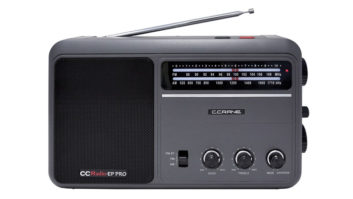EEL PIE ISLAND, United Kingdom — Trevor Baylis, the inventor of the “wind-up radio” technology that powers many emergency and humanitarian radio receivers today, died at his home on the United Kingdom’s Eel Pie Island (near Twickenham) on March 5. He was 80.
“Trevor Baylis deserves ground breaking credit for the first higher quality windup radio commonly available,” said Bob Crane, radio innovator and owner of the C. Crane Company retail/online electronics store (www.ccrane.com). “His original BayGen radio worked well even if the rechargeable batteries were dead. The audio was pleasing.”
Although not personally trained as an engineer, Baylis was fascinated by all things mechanical (an interest encouraged by his engineer father). Following an amateur swimming career — he just missed making it to the 1956 Olympics — Trevor Baylis became a professional aquatic entertainer, including performing an underwater act at a Berlin circus.
[Read: Local Radio Rebuilds Society in South Sudan]
The death of a friend on the trapeze made him realize that “disability is only a banana skin away,” Baylis told the Telegraph newspaper in 2014. In response, “I invented and developed a range of products for the disabled called Orange Aids,” he said. “I made more than 200 products, including one-handed nail clippers and bottle openers.”
In 1991, Baylis invented the Wind-Up/Hand-Crank Radio, which was eventually marketed as the BayGen Freeplay Radio and sold in various bandwidth configurations. They are sold today under the Freeplay Energy brand name here.
The technology works by the user hand-turning a crank that winds up a large internal spring. As the clockwork-style spring unwinds, it turns an onboard generator that powers the radio. Some Freeplay models can charge a radio’s internal batteries for long-term use, plus the batteries of connected devices such as like smartphones.
The wind-up radio’s invention “was pure chance,” Baylis told the Telegraph. “I was watching television in 1991 and there was a program on the spread of AIDs in Africa. They said a good way to tackle it was through educational radio programs, but a lot of the continent did not have access to electricity, and batteries were expensive,” he said.
“I had a prototype for the wind-up radio within half an hour,” he continued. “The original ran for 14 minutes before needing to be wound up again, but it improved.”
Baylis’ wind-up radio went nowhere until he showed it on BBC-TV’s “Tomorrow’s World” in 1994. This led to a backer coming forward, funding the BayGen FreePlay Radio for sale to aid groups, and eventually consumers as well.
The invention of the wind-up radio inspired many manufacturers to come up with similar models; a fact that didn’t help Baylis’ fortunes due to his lack of adequate patent protection.
“I got more money from the publicity around the radio than the actual radio,” Baylis told the Telegraph. “These large corporations can circumnavigate your patents.”
Nevertheless, Baylis’ invention has made a difference to aid agencies such as Ears to Our World (ETOW), which provides radios to Third World communities.
[Read: The FreePlay Plus Radio]
“We still deploy hand-crank radios in Haiti, Kenya, South Sudan, Cameroon and other countries where remote areas lack a power grid,” said ETOW Executive Director Thomas Witherspoon. “Although a number of solar options exist, solar radio require forethought — setting it in the sun to charge — whereas hand-crank radios are ready anytime,” he said.
“I would note that Trevor has had a profound humanitarian impact,” Witherspoon added. “Although various forms of hand-crank powered devices have been around since before WWII, Trevor made them accessible, affordable and implemented in a portable form factor. His clockwork radio changed the nature of self-powered devices.”
“He has touched everyone that knew of his purpose and accomplishments,” said Crane. “His avid supporters included Nelson Mandela, the Queen Elizabeth II, Tom Hanks, and a million C. Crane customers.”













